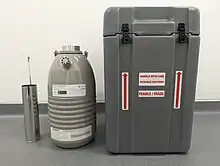Dry shipper
A dry shipper, or cryoshipper, is a container specifically engineered to transport biological specimens at cryogenic temperatures utilizing the vapor phase of liquid nitrogen.[1][2]

Function
The architecture of a dry shipper encompasses two primary components: an internal canister and an external protective shell. The inner canister, designed to hold biological specimens, is positioned within the vapor phase of the liquid nitrogen.[1] This configuration ensures that the specimens are maintained at temperatures below -150 °C for prolonged durations.[2] A distinctive feature of dry shippers is their ability to avert direct contact between samples and liquid nitrogen, reducing risks of contamination and ensuring consistent cryogenic conditions during transit.[1]
Applications
Dry shippers serve various sectors in both the scientific and medical arenas.[1][3] In the realm of reproductive medicine, these containers facilitate the transportation of delicate biological entities, including human ova and embryos.[2] Within the research landscape, they are employed to carry materials such as spermatozoa or preimplantation embryos of genetically modified mouse strains, safeguarding the integrity and viability of these research assets during their journey.[1][4][5] Moreover, biobanks, which archive diverse biological specimens for subsequent scientific exploration, utilize dry shippers to dispatch and acquire samples from researchers worldwide.[3]
Alternative for specimen transport
One common alternative to dry shippers is using dry ice. This method reduces package weight and costs since there's no need for return shipping, unlike with dry shippers. However, at -80 °C, dry ice might not provide a temperature low enough for all specimens. For instance, while cryopreserved mouse spermatozoa can handle this temperature for short periods without losing their fertilization capacity, cryopreserved mouse embryos require colder environments, such as those below -150 °C in dry shippers, to maintain their quality.[6][7][8] Another method is shipping freeze-dried samples at ambient temperatures, as seen with freeze-dried mouse spermatozoa. This can be more cost-effective, but many samples, when freeze-dried, experience a notable decline in quality, limiting its applicability.[9]
References
- Harrison, Charlotte (2021). "Mice on the move". Lab Animal. 50 (9): 233–235. doi:10.1038/s41684-021-00829-5. ISSN 0093-7355. PMID 34373647. S2CID 236968000.
- Chang, C.-C.; Bernal, D.P.; Wright, G.; Straub, R.J.; Witt, M.A.; Nagy, Z.P. (2009-10-21). "High survival rates of vitrified human oocytes are maintained after exposure to transport conditions in the vapor phase of liquid nitrogen in dry shipper for 60 hours". Fertility and Sterility. 92 (3): S183. doi:10.1016/j.fertnstert.2009.07.1379.
- Nouvel, Agathe; Laget, Jonas; Duranton, Flore; Leroy, Jérémy; Desmetz, Caroline; Servais, Marie-Dominique; de Préville, Nathalie; Galtier, Florence; Nocca, David; Builles, Nicolas; Rebuffat, Sandra; Lajoix, Anne-Dominique (2021-10-25). "Optimization of RNA extraction methods from human metabolic tissue samples of the COMET biobank". Scientific Reports. 11 (1): 20975. Bibcode:2021NatSR..1120975N. doi:10.1038/s41598-021-00355-x. ISSN 2045-2322. PMC 8545963. PMID 34697345.
- Ramin, Michael; Bürger, Antje; Hörlein, Andreas; Kerkau, Dagmar; von Walcke-Wulffen, Vincent; Nicklas, Werner; Schenkel, Johannes (2014). "Stability of Cryopreserved Samples of Mutant Mice". Biopreservation and Biobanking. 12 (5): 343–350. doi:10.1089/bio.2014.0030. ISSN 1947-5535. PMID 25340944.
- Takeo, Toru; Kaneko, Takehito; Haruguchi, Yukie; Fukumoto, Kiyoko; Machida, Hiromi; Koga, Mika; Nakagawa, Yoshiko; Takeshita, Yumi; Matsuguma, Toyokazu; Tsuchiyama, Shuuji; Shimizu, Norihiko; Hasegawa, Takanori; Goto, Motohito; Miyachi, Hitoshi; Anzai, Masayuki (2009). "Birth of mice from vitrified/warmed 2-cell embryos transported at a cold temperature". Cryobiology. 58 (2): 196–202. doi:10.1016/j.cryobiol.2008.12.011. PMID 19168045.
- Okamoto, Masanori; Nakagata, Naomi; Toyoda, Yutaka (2001). "Cryopreservation and Transport of Mouse Spermatozoa at -79.DEG.C." Experimental Animals. 50 (1): 83–86. doi:10.1538/expanim.50.83. ISSN 1341-1357. PMID 11326428. S2CID 84997032.
- Raspa, Marcello; Guan, Mo; Paoletti, Renata; Montoliu, Lluis; Ayadi, Abdel; Marschall, Susan; Fray, Martin; Scavizzi, Ferdinando (2017-07-01). "Dry ice is a reliable substrate for the distribution of frozen mouse spermatozoa: A multi-centric study". Theriogenology. 96: 49–57. doi:10.1016/j.theriogenology.2017.04.003. PMID 28532839.
- Qiu, Juan; Matsukawa, Kazutsugu; Edashige, Keisuke (2023-09-25). "Equilibrium vitrification of oocytes using low concentrations of cryoprotectants". Cryobiology. 113: 104586. doi:10.1016/j.cryobiol.2023.104586. PMID 37722470. S2CID 262027766.
- Ito, Daiyu; Wakayama, Sayaka; Emura, Rina; Ooga, Masatoshi; Wakayama, Teruhiko (2021-08-05). "Mailing viable mouse freeze-dried spermatozoa on postcards". iScience. 24 (8): 102815. Bibcode:2021iSci...24j2815I. doi:10.1016/j.isci.2021.102815. PMC 8390851. PMID 34471856.
External links
- Capacities of different dry shippers illustrated by the Florida State University